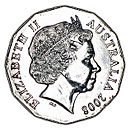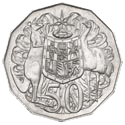Australian fifty-cent coin facts for kids
| Australia | |
| Value | 0.50 AUD |
|---|---|
| Mass | 15.55 g |
| Diameter | 31.65 (across flats) mm |
| Thickness | 2.80 mm (maximum) |
| Edge | Plain |
| Shape | Dodecagonal |
| Composition | 75% copper, 25% nickel |
| Years of minting | 1969–present |
| Catalog number | — |
| Obverse | |
 |
|
| Design | Elizabeth II, Queen of Australia |
| Designer | Ian Rank-Broadley |
| Design date | 1999 |
| Reverse | |
 |
|
| Design | Australian coat of arms |
| Designer | Stuart Devlin |
| Design date | 1965 |
The Australian fifty-cent coin is a special twelve-sided coin. It's the third-highest value coin in Australia and the biggest coin you'll find in your pocket! This unique coin is shaped like a dodecagon, which means it has 12 sides. It's one of only two 12-sided coins in the Southern Hemisphere, along with the Cook Island $5 coin.
This coin was first made in 1969. It replaced an older, round fifty-cent coin that was released in 1966. The first round coin was made mostly of silver (80% silver and 20% copper). But the price of silver went up, making the metal in the coin worth more than its 50-cent value! So, the government decided to stop making the silver coin. They replaced it with the 12-sided coin you see today, which is made of cupro-nickel (copper and nickel).
The fifty-cent coin is the largest Australian coin currently in use. It's also the heaviest coin you'll commonly find. Because it's so big, it's often used for special "commemorative" designs. These designs celebrate important events or people.
With a diameter of about 31.65 millimeters, the 50-cent coin is one of the largest coins used around the world. Only a few coins, like the Costa Rican five-hundred-colón and the fifty-franc (CFP), are a little bit bigger.
Some fifty-cent coins from certain years (like 1986, 1987, 1989, 1990, and 1992) were only made for special collector sets, not for everyday use. This means you won't find them in your change.
Fifty-cent coins are considered "legal tender." This means you can use them to pay for things. However, you can only use them for payments up to $5.
The Front of the Coin (Obverse)
The front side of a coin is called the "obverse." On all Australian coins, the reigning monarch (the King or Queen) is shown on the obverse. So far, only Elizabeth II has appeared on the Australian fifty-cent coin.
The fifty-cent coin is special because it has featured five different pictures, or "portraits," of Queen Elizabeth II. Other Australian coins usually only have one or two different portraits.
One unique portrait was used in 2000 for a special fifty-cent coin that celebrated the Queen's visit. This particular design was created by an Australian artist named Vladimir Gottwald. It's the only Australian coin with a Queen's portrait not also used on British money.
The other four portraits of the Queen have been used on all Australian coins during different periods:
- From 1966 to 1984, a portrait by Arnold Machin was used.
- From 1985 to 1998, a portrait by Raphael Maklouf was featured.
- From 1999 to 2019, a portrait by Ian Rank-Broadley was used.
- Since 2019, a portrait by Jody Clark has been on the coins.
Special Commemorative Coins
The Australian fifty-cent coin was the very first Australian coin to have a different design on its back (the "reverse" side). This happened in 1970 to celebrate 200 years since Lieutenant James Cook landed in Australia. Since then, many other special designs have been made. The large size of the fifty-cent coin makes it perfect for showing off detailed pictures and messages.
Here are some of the special fifty-cent coins that have been made:
| Year | Subject | Mintage |
|---|---|---|
| 1970 | Bicentenary of James Cook's 1770 voyage | 16,500,000 |
| 1977 | 25th anniversary of the accession of Queen Elizabeth II | 25,000,000 |
| 1981 | Marriage of HRH the Prince of Wales and Lady Diana Spencer | 20,000,000 |
| 1982 | Brisbane XII Commonwealth Games | 49,600,000 |
| 1988 | Australian Bicentenary | 9,000,000 |
| 1991 | 25th anniversary of decimal currency | 4,700,000 |
| 1994 | United Nations International Year of the Family | 21,300,000 |
| 1995 | 50th anniversary of the end of World War II – Edward 'Weary' Dunlop | 15,900,000 |
| 1998 | 200th anniversary of the voyage of Bass and Flinders | 22,400,000 |
| 2000 | Millennium year | 16,600,000 |
| Visit of Queen Elizabeth II | 5,100,000 | |
| 2001 | Centenary of Federation | 43,100,000 |
| Centenary of Federation – ACT | 2,000,000 | |
| Centenary of Federation – NSW | 3,000,000 | |
| Centenary of Federation – Norfolk Island | 2,200,000 | |
| Centenary of Federation – NT | 2,100,000 | |
| Centenary of Federation – QLD | 2,300,000 | |
| Centenary of Federation – SA | 2,400,000 | |
| Centenary of Federation – Tasmania | 2,200,000 | |
| Centenary of Federation – Victoria | 2,800,000 | |
| Centenary of Federation – WA | 2,400,000 | |
| 2002 | Year of the Outback | 11,500,000 |
| 2003 | Australia's Volunteers | 13,900,000 |
| 2004 | Primary school design competition winner (John Serrano) | 10,200,000 |
| 2005 | 60th anniversary of the end of World War II | 26,600,000 |
| Secondary school Commonwealth Games design competition winner (Kelly Just) | 20,500,000 | |
| 2010 | Australia Day | 11,400,000 |
| 2014 | 50th anniversary of the Australian Institute of Aboriginal and Torres Strait Islander Studies | 3,000,000 |
| 2016 | 50th anniversary of decimal currency | 7,000,000 |
| 2017 | 50th anniversary of the 1967 Referendum / 25th anniversary of the Mabo Decision | 1,400,000 |
| 2019 | International Year of Indigenous Languages | 2,000,000 |
| Reference: | ||
See also

